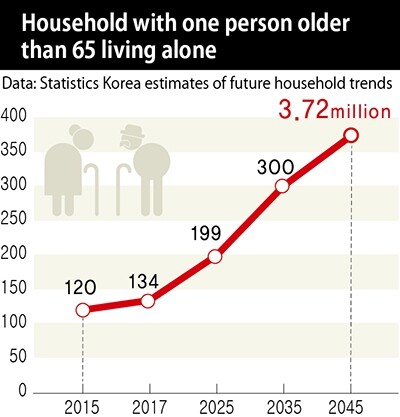hankyoreh
Links to other country sites 다른 나라 사이트 링크
Over next 30 years, numbers of traditional families will halve, elderly people living alone will triple

With South Korea’s birth rate extremely low and the population continuing to age, the traditional structure of the family is rapidly disintegrating. Over the next 30 years, it is estimated that the number of traditional families, in which parents and children live together, will be nearly halved, while the number of elderly people (65 and older) living by themselves will triple.
According to estimates of future household trends between 2015 and 2045 released by Statistics Korea on Apr. 13, the number of households in which parents and children live together will decrease to 3.54 million in 2045, which is 57.7% of the 6.13 million such households in 2015. This represents a decline in the share of the total from 32.3% to 15.9%. Households composed of parents and children will remain the most common type of household through 2017, with a 30.4% share, exceeding single-person households (28.5%) by a slim margin, but single-person households are expected to take the lead in 2019.
The share of single-person households is expected to continue increasing for the time being. In 2015, there were 5.18 million single-person households, or 27.2% of the total, and in 2045, after 30 years, this will increase to 8.1 million households (36.3%). The estimates indicate that the number of elderly single-person households is soaring because of the trends of the low birth rate and population aging. In 2015, there were 1.2 million people 65 years old and above living by themselves, representing 23.2% of single-person households; during the three decades through 2045, this is expected to more than triple to 3.72 million (45.9% of the category).
The government predicts that the number of elderly households (in which the head of the household is 65 or older) will greatly increase relative to the total number of households. The total number of households is projected to increase from 19.01 million in 2015 to a peak of 22.34 million in 2043 before declining to 22.32 million in 2045. The number of households in which the householder is 65 or older is expected to increase from 3.66 million (19.3% of total households) in 2015 to 10.65 million (47.7%) in 2045 – with elderly households representing nearly half of all households. Because of the decline in the number of marriages, Statistics Korea predicts that the percentage of householders with a spouse will decline by 14.6 percentage points through 2045.
“Prior to this, it was more common for single-person families to form as families grew smaller and split up, with some family members relocating because of their jobs. In the future, it will be more common for single-person families to form because of bereavement. These figures are significant in helping us predict how the trends of the low birthrate and population aging will change the lives of our families,” said Lee Ji-yeon, head of population statistics for Statistics Korea.
Statistics Korea’s estimates of future household trends attempt to use the population and housing census, which is conducted every five years, to predict changes over the next 30 years, assuming that recent household growth trends continue. The government started making these estimates in 2002, and this was the fourth time it has released them. Comparing the latest estimates with the previous estimates (from 2012), projections for single-person households in 2035 are at a similar level. However, estimates of the number of households of married couples and households of married couples and children living together (which are based on the marriage rate) were down by 490,000 and 260,000, respectively. This appears to reflect the fact that the marriage rate has been falling sharply over the past five years.
By Noh Hyun-woong, staff reporter
Please direct questions or comments to [english@hani.co.kr]

Editorial・opinion
![[Column] Park Geun-hye déjà vu in Yoon Suk-yeol [Column] Park Geun-hye déjà vu in Yoon Suk-yeol](https://flexible.img.hani.co.kr/flexible/normal/500/300/imgdb/original/2024/0424/651713945113788.jpg) [Column] Park Geun-hye déjà vu in Yoon Suk-yeol
[Column] Park Geun-hye déjà vu in Yoon Suk-yeol![[Editorial] New weight of N. Korea’s nuclear threats makes dialogue all the more urgent [Editorial] New weight of N. Korea’s nuclear threats makes dialogue all the more urgent](https://flexible.img.hani.co.kr/flexible/normal/500/300/imgdb/original/2024/0424/7317139454662664.jpg) [Editorial] New weight of N. Korea’s nuclear threats makes dialogue all the more urgent
[Editorial] New weight of N. Korea’s nuclear threats makes dialogue all the more urgent- [Guest essay] The real reason Korea’s new right wants to dub Rhee a founding father
- [Column] ‘Choson’: Is it time we start referring to N. Korea in its own terms?
- [Editorial] Japan’s rewriting of history with Korea has gone too far
- [Column] The president’s questionable capacity for dialogue
- [Column] Are chaebol firms just pizza pies for families to divvy up as they please?
- [Column] Has Korea, too, crossed the Rubicon on China?
- [Correspondent’s column] In Japan’s alliance with US, echoes of its past alliances with UK
- [Editorial] Does Yoon think the Korean public is wrong?
Most viewed articles
- 1‘We must say no’: Seoul defense chief on Korean, USFK involvement in hypothetical Taiwan crisis
- 2N. Korean delegation’s trip to Iran shows how Pyongyang is leveraging ties with Moscow
- 346% of cases of violence against women in Korea perpetrated by intimate partner, study finds
- 4[Column] Park Geun-hye déjà vu in Yoon Suk-yeol
- 5‘Weddingflation’ breaks the bank for Korean couples-to-be
- 6Will NewJeans end up collateral damage in internal feud at K-pop juggernaut Hybe?
- 7Amnesty notes ‘erosion’ of freedom of expression in Korea in annual human rights report
- 8[Interview] Dear Korean men, It’s OK to admit you’re not always strong
- 9Korean government’s compromise plan for medical reform swiftly rejected by doctors
- 10[Editorial] Japan’s rewriting of history with Korea has gone too far